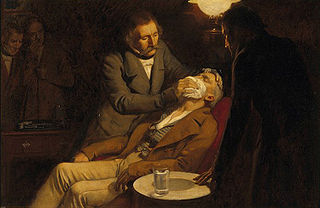*Image Credit: Wikimedia Commons Though a necessary part of surgical procedures of any kind today, the idea of anesthesia was considered somewhat of a hoax until October 16, 1846. That day, in an operating room at Massachusetts General Hospital in Boston, William T.G. Morton put a man under using ether in order for the patient to have a tumor removed. For Morton, the journey to acclaim had been a long and winding road. He began his career as a salesman before moving to Maryland to study dentistry in 1840. While there, he created a more efficient means to secure false teeth to the bridges that held them in the client’s mouth. Sensing an opportunity, he opted to forgo the end of his education in order to join a dental practice in Connecticut. Partnered with Horace Wells, things seemed to be going great for Morton — the business was doing well and he had met a delightful woman, Elizabeth Whitman, whom he was determined to make his wife. Upon proposing marriage to her parents, he learned of their distaste for his chosen line of work. When he agreed to pursue a medical degree, the Whitmans relented and they were married. After enrolling at Harvard Medical School in 1844, Morton connected with chemist Charles T. Jackson. Learning of ether’s ability to numb pain, the former dentist surmised he could use the substance to great effect in the operating room. On September 30, 1846, he decided to test the theory while pulling a decaying tooth from the mouth of a sedated patient. It worked. Seeing a report of the event in a local paper, a Boston-area doctor arranged for Morton to demonstrate his technique at Massachusetts General. With students gathered around Dr. John Collins Warren in the operating theater, Morton gently held an inhaler filled with ether near the mouth of Edward Abbott, the patient. Once Abbott drifted off, Warren removed a growth from the side of his neck. The patient never moved. The audience, rapt with interest as Abbott regained consciousness, listened intently as he came to. According to legend, upon hearing Warren ask how he was feeling, Abbott replied, “Feels as is if my neck’s been scratched.” Warren beamed back at the classroom and Morton, likely seeking to lay the foundation for a lucrative venture, informed the crowd the substance was “letheon.” Once the material was revealed to be ether, Morton became something of a pariah. Working vigorously to patent his “invention” and ensure he alone received credit for the discovery, Morton was soon on the receiving end of disdain from his former associates and the medical community at large. Though it would later be discovered that Crawford Long had performed a procedure using ether earlier — the results weren’t published until 1849 — the Ether Dome, as the room is now known, is listed as a National Historic Landmark by the United States National Park Service. Also On This Day: 1793 – Queen Marie Antoinette is executed as part of the French Revolution 1905 – The Partition of Bengal occurs in India 1923 – The Walt Disney Company is founded by brothers Walt and Roy Disney 1940 – Nazis establish the Warsaw Ghetto for Jews in Poland’s capital 1968 – American sprinters Tommie Smith and John Carlos are kicked off the Olympic team for a Black Power salute on the medal stand for the 200-meter dash
October 16 1846 CE – William T.G. Morton Demonstrates Surgical Anesthesia
*Image Credit: Wikimedia Commons Though a necessary part of surgical procedures of any kind today, the idea of anesthesia was considered somewhat of a hoax until October 16, 1846. That…
550
